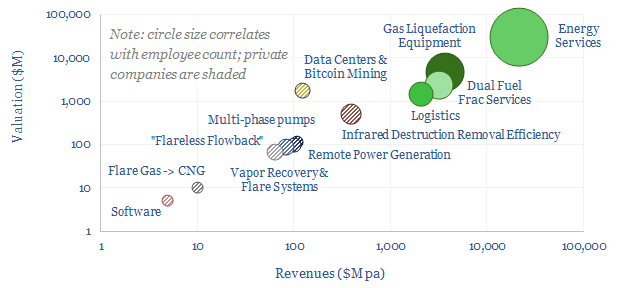This data-file is a screen of companies that reduce gas flaring emissions, either by avoiding routine flaring directly, or by reducing the ESG impacts of unavoidable flaring. The landscape is broad, ranging from large, listed and diversified oil service companies with $30bn market cap to small private analytics companies with <$10M pa of revenues.
Our screen explores a dozen companies that reduce gas flaring and can help to mitigate flaring; whether they are public or private, their size, headcount, focus, revenues, valuation, and an overview of their technology. But this is just a sample of names, to illustrate the breadth of the theme.
Breadth and the giant furnace model. There is a dangerous temptation to assume that oil industry flaring is simple. It is vastly complex. Flaring rate by country range from effectively nil in industry-leading Norway and Saudi Arabia through to 0.7 mcf/bbl in the highest-flaring producing countries. And even where flaring does occur, beware assuming there is some kind of giant furnace in the desert of Texas where the shale oil industry ‘chooses to burn off waste gases’.
The reality is borne out by this screen. Avoiding flaring requires oilfield service equipment to separate out gas from produced oil. Moving it away from the well site then requires compressors, pipelines, small-scale LNG, CNG or using gas in basin, e.g., for dual-fuel rigs or frac services or in-basin power generation. Sometimes it is not possible to separate the gas, and fluids must be moved by multi-phase pumps. Sometimes wells are flowed back before gas infrastructure is available. Sometimes, despite extensive separation, gas still flashes off in storage tanks. Sometimes flaring is unavoidable, and the goal is simply to ensure all methane is effectively destroyed in the flare, and not leaked away.
The emissions tab contains a similar calculator for the CO2 intensity of flaring, depending on the gas-oil-ratio, percent of gas that is flared, combustion efficiency and timeframe over which methane emissions are considered. We believe that poorly-managed flaring operations from some oil production sites around the world will emit more CO2 than burning the resultant oil itself, due to methane slip. Whereas emissions from flaring are negligible for high-quality producers.
